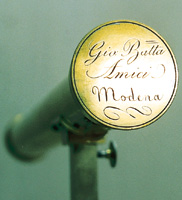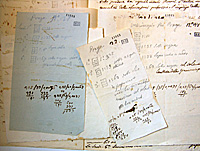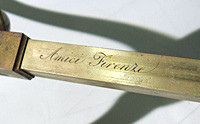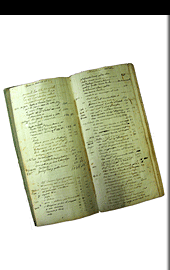Documents
The workshop and the Workshop Account Book
Different from most of the instrument makers at that time in London, Paris and Munich – who could count on real factories where in some cases dozens of workers were employed in the production of optical and mathematical instruments – Giovanni Battista Amici’s production was always carried out in a workshop, located near his home, where instruments were made by hand with the help of at most four workers (and in certain periods only one) .
On one hand, the economic and political conditions of Italy at that time have to be taken into account: it was improbable in those conditions that the same quantity of orders arrived to Amici as arrived to instrument makers in other countries. This was especially true of England and France, naval powers intent, among other activities, on surveying vast areas of the globe. On the other hand, the constant difficulty of finding not only optical glass, lacking in Italy, but also high quality optical workers must be kept in mind. In fact, Amici had to repeatedly search for workers in Padua, Lombardy and even in Switzerland. Even in Milan in the 1820s it was not easy to find good quality brass for the mechanical parts. Nor should we forget that at the time of his famous catadioptric microscope, in the second decade of the 1800s and for many years after, the use of the microscope in the universities of Europe was so rare that a large-scale production of them would not have been justified.
 Lastly, bear in mind that the largest telescopes built by Amici, the reflector in 1811 for Brera and the refractor in 1841 for Florence, were never adequately mounted nor housed in a suitable observatory.
Lastly, bear in mind that the largest telescopes built by Amici, the reflector in 1811 for Brera and the refractor in 1841 for Florence, were never adequately mounted nor housed in a suitable observatory.
Amici looked to England and France because he measured himself and his abilities against those of the greatest makers of those countries, but he did not have a supportive situation at home in Italy.
His workshop was always located in the buildings where his family lived: in Modena in the Contrada de’ Servi, in Florence first in Via Maggio, then in Via de’ Renai, in the palace facing the Arno near the Ponte alle Grazie, which today houses Hotel Silla and at that time belonged to Prince Demidoff. And he never mixed his personal workshop with that of the Royal Museum.
 As for Amici’s workers, we know that Giuseppe Sgarbi worked for him in Modena during the 1811-1826 period (on 1 January 1827 he became the machinist and custodian in the new Observatory) and occasionally perhaps until 1831. Gaspare Palmieri worked for Amici from 1814 to 1817; he had received his training in Brera from Joseph Megele of Vienna, the chief technician of the Observatory. A worker called “the Genevan” worked for Amici from 1817 to 1823. In 1818 Pietro Bacchi of Modena worked with him; he then opened his own shop to construct optical instruments. Osvaldo Ferracina worked there from 1824 to 1826. Giovanni Battista Lenna worked with him from 1817 to 1843 and was the head of the workshop for many years. Lenna came from Brera, too, where he had learned his trade with the machinist Carlo Grindel. Guglielmo Pucci entered Amici’s workshop in 1821 at fifteen years of age and remained there until 1837. When Amici transferred to Florence in 1831, he brought Lenna and Pucci with him. Giuseppe Braidi worked with him from 1831 to 1833, in Florence. Lodovico Saetti from 1832 to 1834. A not-better-defined Raffaello (it could be Raffaello Grossi) worked with him in the 1839-1843 period. There were others who worked with him for shorter periods, occasionally or as external contractors. We have no information of Amici’s workers after 1843, with the exception of Saetti and Grossi.
As for Amici’s workers, we know that Giuseppe Sgarbi worked for him in Modena during the 1811-1826 period (on 1 January 1827 he became the machinist and custodian in the new Observatory) and occasionally perhaps until 1831. Gaspare Palmieri worked for Amici from 1814 to 1817; he had received his training in Brera from Joseph Megele of Vienna, the chief technician of the Observatory. A worker called “the Genevan” worked for Amici from 1817 to 1823. In 1818 Pietro Bacchi of Modena worked with him; he then opened his own shop to construct optical instruments. Osvaldo Ferracina worked there from 1824 to 1826. Giovanni Battista Lenna worked with him from 1817 to 1843 and was the head of the workshop for many years. Lenna came from Brera, too, where he had learned his trade with the machinist Carlo Grindel. Guglielmo Pucci entered Amici’s workshop in 1821 at fifteen years of age and remained there until 1837. When Amici transferred to Florence in 1831, he brought Lenna and Pucci with him. Giuseppe Braidi worked with him from 1831 to 1833, in Florence. Lodovico Saetti from 1832 to 1834. A not-better-defined Raffaello (it could be Raffaello Grossi) worked with him in the 1839-1843 period. There were others who worked with him for shorter periods, occasionally or as external contractors. We have no information of Amici’s workers after 1843, with the exception of Saetti and Grossi.
![]() Pietro Pagnini first revealed the existence of the Workshop Account Book and provided some initial information about it in 1928 (L’ottica geometrica in Italia nella prima metà del secolo XIX e l’Opera di G. B. Amici < Geometric optics in Italy in the first half of the 19th century and the work of G.B. Amici >, “Rassegna nazionale”, XVII). From that first indication Professor Paolo Buffa and Elena Filippini-Lera Buffa began, more recently, to try to locate this precious document, and the generosity of the Amici Grossi Family made it accessible to the scientific community, donating it to the Biblioteca Estense in Modena. The Buffas then presented it in an article which appeared in 1988 in the “Giornale di Fisica” (Il Libro de’ Conti del Laboratorio di Giovan Battista Amici, “Giornale di Fisica”, 2-3).
Pietro Pagnini first revealed the existence of the Workshop Account Book and provided some initial information about it in 1928 (L’ottica geometrica in Italia nella prima metà del secolo XIX e l’Opera di G. B. Amici < Geometric optics in Italy in the first half of the 19th century and the work of G.B. Amici >, “Rassegna nazionale”, XVII). From that first indication Professor Paolo Buffa and Elena Filippini-Lera Buffa began, more recently, to try to locate this precious document, and the generosity of the Amici Grossi Family made it accessible to the scientific community, donating it to the Biblioteca Estense in Modena. The Buffas then presented it in an article which appeared in 1988 in the “Giornale di Fisica” (Il Libro de’ Conti del Laboratorio di Giovan Battista Amici, “Giornale di Fisica”, 2-3).
The part dealing with the Machines sold was published in full, entry by entry, by Alberto Meschiari in the “Atti della Fondazione Giorgio Ronchi” and subsequently in the book Il Libro de’ conti del laboratorio di Giovanni Battista Amici e altri documenti inediti, < Giovanni Battisti Amici’s Workshop Account Book and other unpublished documents >, Tassinari, Florence 2003.
The part about the expenses, instead, i.e., the purchases made for the workshop, which is a little incomplete and discontinuous, has not yet been published.
 Even though it does not record everything that Amici constructed and sold or donated, the Workshop Account Book, kept scrupulously from 9 January 1817 to 25 March 1863, is a document of extraordinary value. It allows us to date with great precision the majority of the instruments which came out of Amici’s workshop over nearly fifty years and to identify who ordered them.
Even though it does not record everything that Amici constructed and sold or donated, the Workshop Account Book, kept scrupulously from 9 January 1817 to 25 March 1863, is a document of extraordinary value. It allows us to date with great precision the majority of the instruments which came out of Amici’s workshop over nearly fifty years and to identify who ordered them.
On these pages we can see that in 46 years the workshop produced just over 300 microscopes, 12 polarizing devices, 25 telescopes (astronomical and terrestrial), 17 micrometers, about 270 camera lucida, seventy or so levels, etc. By comparing the Workshop Account Book to other documents and to the correspondence we can hypothesize that in fifty years there were no more than 400 microscopes constructed in the Workshop. It is important to keep in mind that especially as far as the more versatile achromatic microscope is concerned, Amici’s production was never standardized since the instrument was generally built to respond to the particular needs of the client. This is also the main reason why these instruments could only be purchased from the constructor himself and were not available through distributors, as happened for the majority of the manufacturers.
Types of instruments produced in Amici’s workshop
(according to the Workshop Account Book )
Camera for photographs
Camera lucida
Camera oscura
Diopters
Goniometer
Instruments for polarization and diffraction
Levels
Meridians
Micrometers
Opera glasses
Praetorian tables
Prism reflecting circles
Repeating theodolites
Terrestrial and astronomical telescopes
Surveyors’ crosses
Transit instrument
Geographic distribution of the equipment sold
Amici’s instruments were widely sold in Italy (just to mention a few cities: Arezzo, Bergamo, Bologna, Ferrara, Florence, Genoa, Milan, Modena, Naples, Padua, Palermo, Parma, Pavia, Pisa, Pistoia, Reggio Emilia, Rome, Sassari, Siena, Turin, Venice, Verona, Vicenza), and across Europe (Altona, Amsterdam, Armagh, Berlin, Bonn, Copenhagen, Dublin, Edinburgh, Giessen, Geneva, Greece, Greifswald, Jena, Leipzig, Liverpool, London, Malta, Marseille, Paris, Poland, Prague, Stockholm, Tübingen, Utrecht, Vienna, Zurich), and reached as far east as Moscow and S. Petersburg and as far west as New York, Philadelphia, the Carolinas and Mexico.
Institutional clients
Academy of Copenhagen
Anatomical Institute of Bonn
Anatomical Institute of Prague
Anatomy Laboratory of the University of Pisa
Anatomy Laboratory of the University of Sassari
Anatomy School of Ferrara
Astronomical Observatory of Armagh (Ireland)
Astronomical Observatory of Modena
Astronomical Observatory of Turin
Faculty of Sciences in Paris
Forteguerri College in Pistoia
Ghislieri College in Pavia
Hospitals of Livorno
Human Anatomy Laboratory of the University of Padua
Imperial Institute of the Venetian Region
Imperial Laboratory of Natural History in Vienna
La Sapienza University of Rome
Library of the King of Naples
Natural History Museum in Paris
Naval College in Venice
Pathological Anatomy School of Florence
Pathology Laboratory of the University of Bologna
Physics and Natural History Museum in Florence
Physics Laboratory of the University of Pavia
Physics Laboratory of the University of Pisa
Physiology Laboratory of the University of Siena
Polytechnic School of Paris
Porta Nuova Secondary School in Milan
S. Maria Nuova Hospital in Florence
Sardinian Navy of Genoa and Navy School
School of Mines of Paris
School of Descriptive Anatomy of the S.M.N. Hospital in Florence
Science Academy in Turin
Secondary school of Venice
Topographic Bureau of Naples
Technical Institute of Florence
University of Giessen
University of Modena
University of Naples
University of Parma
University of Perugia
University of Utrecht
Zoological Museum of Turin
Among those who received his isntruments there were
Physicians, biologists, physiologists, anatomists, zoologists, botanists, chemists and geologists
including: Alessandrini, Assalini, Bassi, Bechi, Betti, Brongniart, De Filippi, De La Rive, De Notaris, Donders, Dufrénoy, Ehrenberg, Escher, Gabrielli, Haeckel, Harting, Hasner, Lambl, Lehmann, Mirbel, Mohl, Pacini, Panizza, Parlatore, Passerini, Pellizzari, Purkyne, Savi, Schleiden, Schouw, Schultze, Vlacovich, Webb
Astronomers
including: Bianchi, Binet, Caldecott, Ciccolini, Cooper, J. F. W. Herschel, Horner, Inghirami, Littrow, Oriani, Pearson, Plana, Robinson, Rutherfurd, Santini, Secchi, Valz
Physicists and mathematicians
including: Antinori, Corridi, Gonnella, Hartnack, Matteucci, Orioli, Pacinotti, Pictet, Talbot, Zantedeschi
and then Engineers and architects (including Corsini, Pasqui, Scaccia), military officials and diplomats (including: Carandini, von Köller, Ross, Smyth, Visconti); and Sovereigns and aristocrats (to mention only a few: Archduke Maximilian of Austria, King Gustav of Sweden, the Emperor of Russia, Maria Luigia of Parma, the Prince von Metternich, the King of Naples, the Baron Ricasoli, Victor Emmanuel I).
